Ferrets are creatures that are quite different from most other animals! Their appearance and personality is very unique and makes them a great pet for a wide variety of different people.
If you’re looking into taking home a new pet ferret, you may want to know about the many types of ferrets that exist. Everybody wants to bring home a pet that’s best-suited for them, and a good knowledge about the types of ferrets will help with that.
So, in this post we will be highlighting all of the different kinds of ferrets that exist. This information should give you the knowledge to go find the ferret that’s perfect to bring into your home!
Table of Contents
How Many Types Of Ferrets Are There?
In terms of domesticated pet ferrets, there’s actually only one breed that exists besides the angora ferret. They’re a part of the weasel family and have the Latin name Mustela putorius furo.
However, despite the fact that there’s only one breed, pet ferrets can come in a wide variety of different sizes, colors, and styles. This post will highlight the official colors and color patterns recognized by the American Ferret Association.
The AFA officially recognizes 8 different colors and 7 different color patterns in ferrets (with some other pattern descriptors included). Some sources state that there are more types of ferrets than what the AFA identifies, but those specimens are simply combinations of different colors and patterns.
So what are these different colors and patterns that exist? What exactly do they look like? We’ll go into detail about these characteristics below.
There isn’t a link between ferret color/pattern and personality. A ferret is a single breed, so they all have the exact same needs and roughly the same mannerisms. Some ferret types are prone to deafness/blindness, though.
Colors
- Albino
- Black
- Black Sable
- Champagne
- Chocolate
- Cinnamon
- Dark-Eyed White
- Sable
Color Patterns
- Blaze
- Mitt
- Panda
- Point
- Roan
- Solid
- Standard
Extra Patterns
- Bib
- Marked
- Masked
- Self
- Stocking
8 Different Ferret Colors
The American Ferret Association officially recognizes that there are 8 main colors of ferrets. While there aren’t only 8 styles of ferrets, these are the colors that can combine to make hundreds of different uniquely-styled ferrets.
Some of these colors are more common than others, and some are a bit more loosely-defined.
1. Albino Ferret
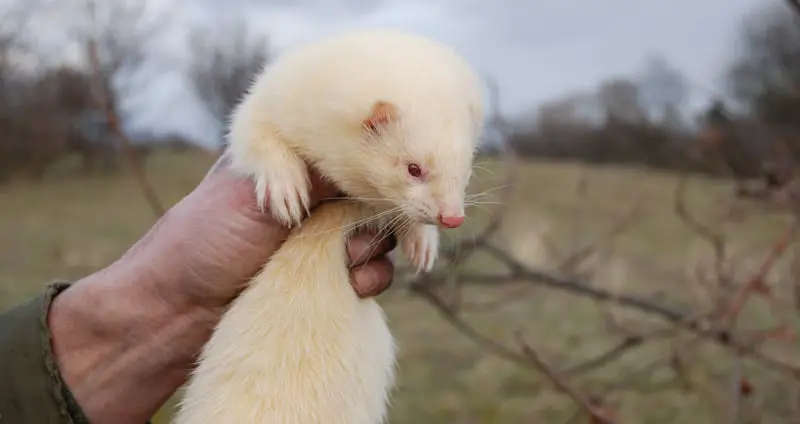



Albinos are easily the most recognizable types of ferrets that exist. Albinism is a lack of pigment in living creatures, and it’s resulted in a unique appearance in ferrets. This ferret has guard hairs and an undercoat that are usually colored white with a hint of cream.
This light coat is contrasted by their striking red eyes and adorable pink nose. Since all albino ferrets lack pigment and are patternless, most specimens look very similar to each other.
Albino ferrets can also be more prone to hearing problems, but that condition is still quite rare and can easily be adapted to if it does occur.
2. Black Ferret
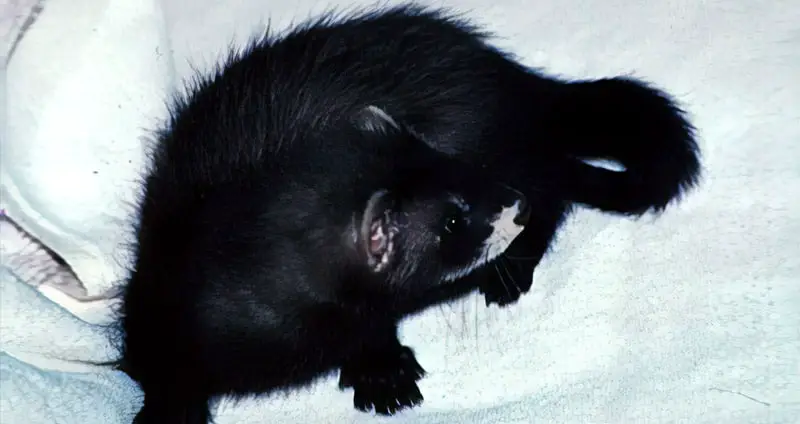



Black ferrets are a type of ferret that live up to their name quite well. This ferret has guard hairs that are straight black in color, with an undercoat that’s primarily white or slightly golden. Its eyes should also be black, if not indistinguishable from black.
The nose is the same way, but it can also be speckled black if the rest of the ferret is true black. Due to the dark color of this ferret, they don’t feature many patterns. Some may have white or light brown patterns on their heads, but it’s usually quite faint.
3. Black Sable Ferret
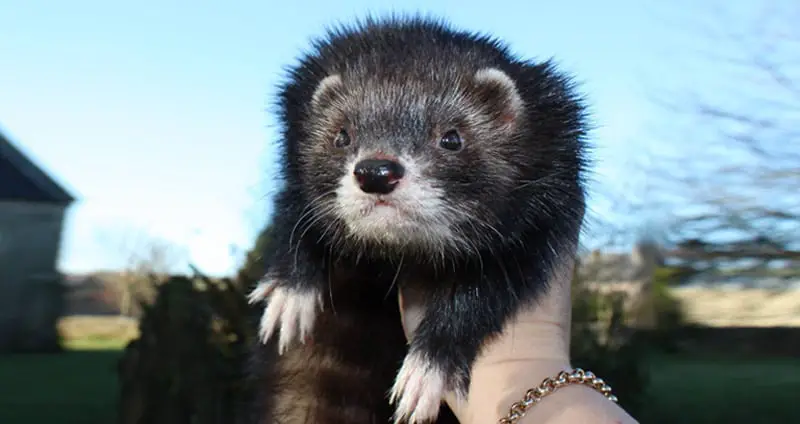



As its name suggests, the black sable ferret has an appearance that’s quite similar to a sable ferret but features darker brown color. A black sable ferret’s guard hairs are blackish brown without any “warm” tones, and their undercoat ranges from pure white to cream.
The rest of them is quite dark, too, with near-black or dark brown eyes and a blackish brown nose. Although this ferret has “black” in the name, it’s ultimately defined by its blackish brown fur, unlike the black ferret.
4. Champagne Ferret
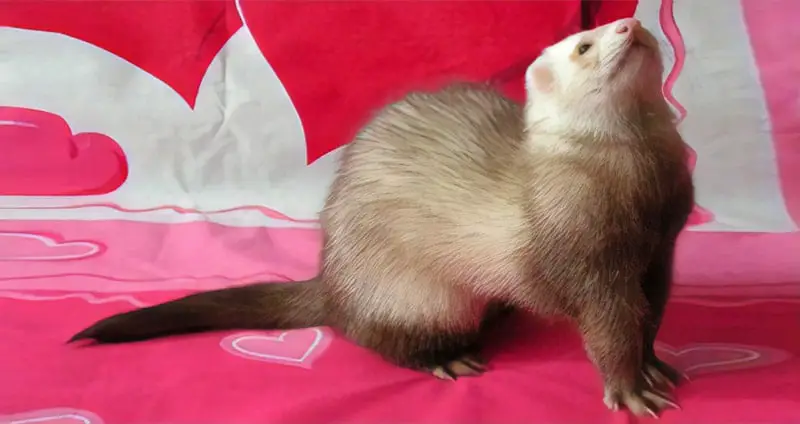



This is a ferret that’s commonly described as a “diluted” chocolate ferret, featuring an all-around lighter color. Their guard hairs are colored tan or light brown, with an undercoat that ranges from white to cream.
There’s a bit of leeway when it comes to a champagne’s eyes, as they can range from a light to dark burgundy. A champagne’s nose can also be a few different colors, but it’s preferred to be either beige, pink, or pink with a beige outline. This is one of the lightest types of ferrets.
5. Chocolate Ferret
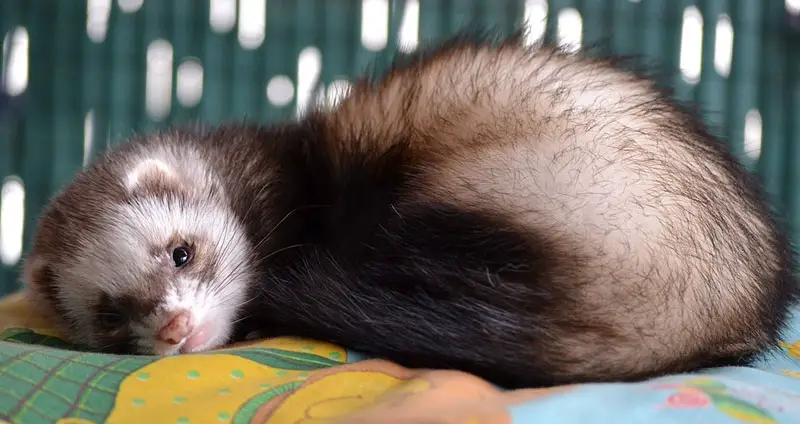



This is a type of ferret that clearly resembles its name. The chocolate ferret has guard hairs that are described as warm milk chocolate brown and an undercoat that ranges from white to a slight golden hue.
Their eyes can either be brown or dark burgundy, and their nose can be pink, beige, or pink with a light brown outline. It’s also noted that this ferret should have a full mask across their eyes, adding a break in color to their (generally) whiter face.
6. Cinnamon Ferret
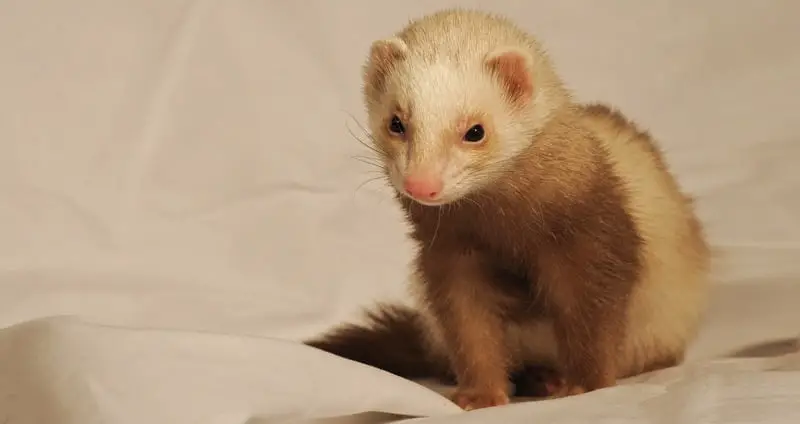



Cinnamon ferrets are quite unique since their fur features a hint of red coloring. Their guard hairs feature a strong reddish brown color, and their undercoat ranges from a golden hue to plain white.
Like champagnes, cinnamon ferrets can have eyes ranging from light to dark burgundy. Their noses are preferred to be brick colored, but they can also be beige/pink or simply pink. Cinnamon ferrets may look quite similar to champagnes, but they tend to be harder to come by.
7. Dark-Eyed White Ferret
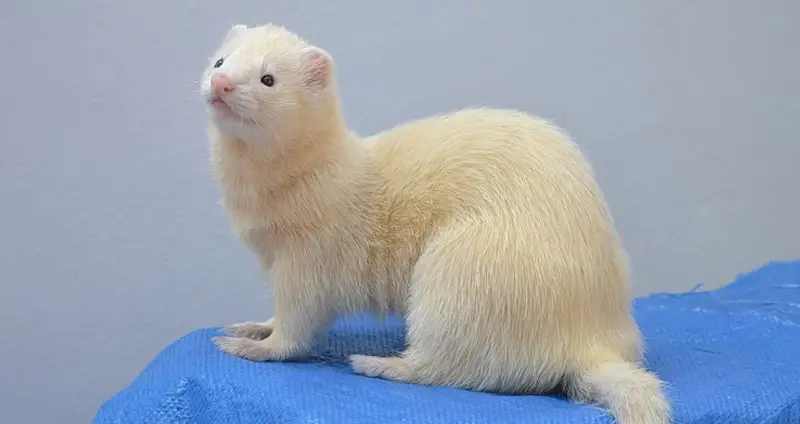



One thing to note about this type of ferret is that it’s always referred to as dark-eyed white, even if they feature another color. Their guard hairs and undercoat range from white to cream, and their eyes and nose are burgundy and pink, respectively.
There’s not a lot of variation in this ferret color, which makes it similar to the albino ferret. Essentially the only physical difference between dark-eyed white and albino ferrets are their eye colors.
This type of ferret is also more prone to hearing problems like albinos are.
8. Sable Ferret
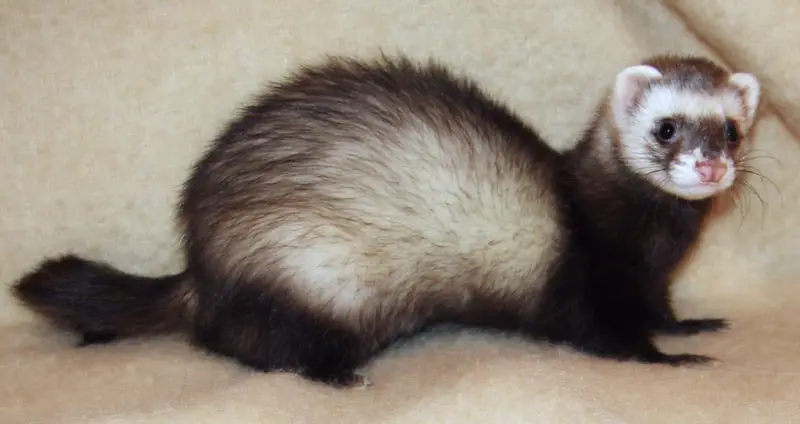



Sable ferrets are the most common type of ferret, but that doesn’t mean that their appearance is boring. They have guard hairs that are a warm, deep brown, and their undercoat ranges from white to cream.
Their eyes are a blackish brown, and their nose can either be light brown or a speckled brown. If you walk into a pet store that has ferrets, the chances of those ferrets being sables are quite high.
7 Different Ferret Color Patterns
While there are 8 different colors that ferrets can come in, those colors can be arranged in 7 officially-recognized patterns. Understanding the different patterns will help you identify a certain ferret type despite them having a more unique appearance.
- 9. Blaze Ferret – The blaze pattern is easily one of the most complicated patterns in terms of identifying traits. On the head of a blaze ferret, there is a long white stripe or “blaze” that runs from the forehead to between the ears and down the back of the neck to the shoulders. While mask colors will vary, full masks aren’t acceptable and are limited to small masks or rings around the eyes. The eyes can be colored ruby to brown, and the nose can be pink or pink with a light outline. Additionally the front and hind feet should have white tips or mitts. Other acceptable markings include knee patches, white tips on tails, bibs, white or speckled bellies, and roaning.
- 10. Mitt Ferret – Mitts are essentially ferrets that have white fur on their feet that ends at the ankle. This fur should be present on all 4 feet and should be uniform in appearance. Specific characteristics of mitts, such as the presence of matching bibs, depend on the color of the ferret being analyzed.
- 11. Panda Ferret – While the panda pattern is easy to spot, it doesn’t actually look much like a panda bear. Instead, this pattern features an almost completely white head, including the throat and neck. Colored rings around the eyes can be present, and mitts should be present on all 4 feet. Additionally, knee patches and a white tip on the tail can also be present.
- 12. Point Ferret – Also known as the Siamese pattern, the point pattern features color discrepancies between a ferret’s body color and the end points of their body. These points include feet, legs, tails, shoulders, and faces. Often times these ferrets will end up having similar-looking coats to Siamese cats, hence the name.
- 13. Roan Ferret – The roan pattern means that a ferret has 50% to 60% colored guard hairs and 40% to 50% white guard hairs. This results in a ferret that has a more faint color than normal with colored guard hairs that seem sparse and spread out. One thing to note about this pattern is that the colored guard hairs can’t also be white, so white ferrets can’t have this pattern.
- 14. Solid Ferret – The solid pattern speaks for itself. This is a pattern where a ferret’s fur is all one color without any white fur breaking up the color. Ferrets with this pattern are quite striking and very easy to identify. Note, though, that white ferrets can’t have this pattern either.
- 15. Standard Ferret – This is a pattern that’s very similar to solid but has a few differences. Colored guard hairs will be about 90% to 100% in relation to white guard hairs, making color concentration lighter than that in solid ferrets. This also results in points being more easily discernible.
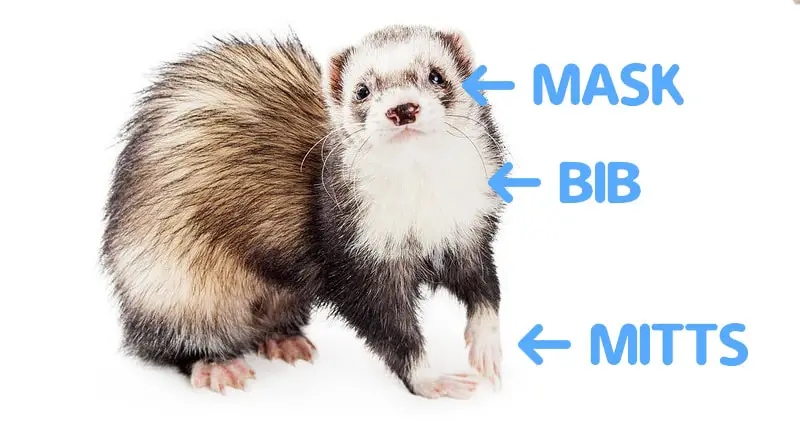



5 Extra Patterns In Ferrets
There are a few more patterns that are present in ferrets. These aren’t defining patterns in themselves, but they can be used to help identify the 7 main patterns or one of the 8 main ferret colors.
- Bib – A white patch of fur underneath a ferret’s neck. Often times bibs are present when mitts are present and have the same color.
- Marked – This is a line of color running down the back of a ferret and onto their tails. These streaks can range from thin to thick and can occur in a variety of different colors.
- Masked – These ferrets have a band of color around and between their eyes, giving an appearance that’s similar to a racoon. Masks can span across a ferret’s entire face or just provide a circle of color around each individual eye.
- Self – Self ferrets have a solid color from their head to their tail, but they may also have white at their nose and lighter fur above their eyes. Additionally, their undercoats tend to be less visible.
- Stocking – Stocking ferrets are quite similar to mitt ferrets, with the difference being that the mitt extends past the ankle, usually stopping halfway up the leg.
Unfortunate Reality Of Ferret Breeding
Essentially all ferret colors and markings are a direct result of genetic mutations. The only two standard ferrets, sables and albinos, are among the least popular types of ferrets among owners. Therefore, a lot of breeding is done to produce more unique and desirable ferrets, often resulting in inbreeding and serious health problems.
For example, ferrets that have a blaze or panda pattern are alarmingly likely to have Waardenburg syndrome, which results in deafness, cranial deformities, and intestinal issues.
Dark-eyed white ferrets are also susceptible to this disease. Researchers have estimated that up to 75% of panda and blaze ferrets are deaf, with the remainder having some level of hearing difficulties.
While standard ferrets aren’t guaranteed to have great genetic health, non-standard ferret types are often indicative of poor health. It’s important to consider this fact before looking for a new ferret to bring into your home.
If you’re looking to purchase a ferret from a ferret breeder, make sure that they’re actively avoiding these health issues.
What Type Of Ferret Is Best As A Pet?
Ultimately, that’s up to you! As discussed above, some ferrets do have health issues, so it may be in your best interest to avoid those colors and patterns. However, aside from that, there isn’t a difference between the different ferret colors and patterns in terms of personality!
Since domesticated ferrets are all one breed, they’re all quite similar. Of course, personalities will differ between ferrets as some will naturally be more energetic, curious, feisty, or sleepy than others.
Because of this, you’ll want to look for a ferret that behaves in an optimal way, in addition to looking how you want it to look. When a ferret is given the proper cage, food, and affection, though, there’s a very good chance that it will make for a very loving and fun pet.

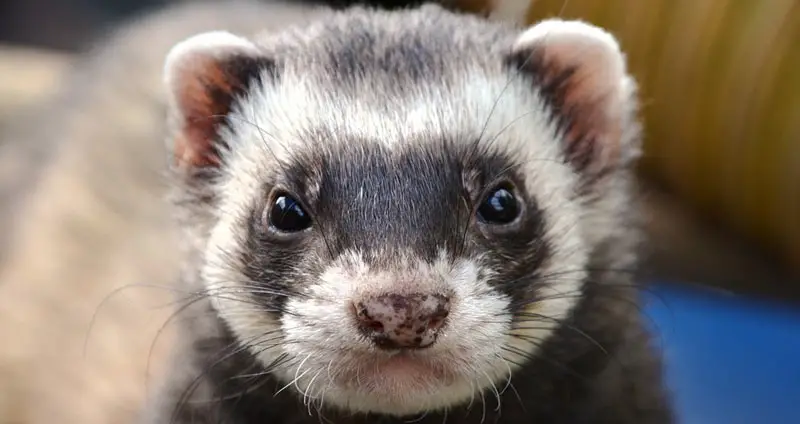
I’ve never had such a closer bond with another animal, it was mine and my wife’s favorites pets we’ve ever owned. Quiet cute and cuddly you can’t get any better than that.